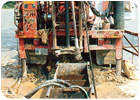
In the direct-mud rotary drilling method, the borehole is advanced by rapid rotation of a drill bit mounted on the end of the drill rods. The bit cuts and breaks the material at the bottom of the hole into small pieces (cuttings). The cuttings are removed by pumping drilling fluid (water or water mixed with a fluid enhancer, such as bentonite) down through the drill rods and bit and up the annulus between the borehole and the drill rods. The drilling fluid also serves to cool the drill bit and stabilize the borehole wall, to prevent the flow of fluids between the borehole and surrounding earth materials, and to reduce cross-contamination between aquifers.
Direct-mud rotary drilling offers a number of advantages. It is a very fast and efficient means of drilling. Efficient rigs can produce several thousand feet of hole per day. The direct-mud rotary method can reach to several thousand feet in depth and create hole diameters greater than 48 inches. The method is adaptable to a wide range of geologic conditions. Only exceptionally large, poorly stabilized boulders or karst (cavernous) conditions are unsuited for direct-mud rotary drilling.
Sediment sampling is broadly supported in direct-mud rotary drilling. Standard split-barrel and thin-wall sampling are available in poorly lithified materials, while a broad range of coring equipment is supported for consolidated rock. Hydrologic conditions have little effect on direct-mud rotary drilling; operations usually are unhindered by the presence of ground water. Direct-mud rotary drilling readily supports the telescoping of casings to successively smaller sizes to isolate drilled intervals and to protect lower geologic units from contamination by previously drilled, contaminated upper sediments.
Direct-mud rotary drilling has some inherent disadvantages for monitoring well installation. If the drilling mud is not carefully engineered, drilling fluids may invade permeable zones, compromising the validity of subsequent monitoring well samples from those intervals. The mud cake necessary to hole stability usually will interfere to some extent – by ionic exchange – with the analysis of monitoring well water samples. Organic compounds that commonly are added to drilling fluids also may interfere with chemical and physical tests on sediment samples. Poorly engineered drilling fluids may produce difficult-to-remove mud cakes that inhibit the flow of fluids to the well. Relatively large volumes of cuttings and drilling fluids may provide containment problems, and must be disposed of properly.
At sites being monitored for hydrocarbons, inherently complex rotary rigs may introduce grease and oil to the monitoring system. Mud pumps, water swivels, rotary drives, rod connections and drilling fluid components all may contribute hydrocarbons inadvertently to the system, despite the best decontamination/degreasing efforts. When water or other materials are introduced to the drill hole, those materials must be sampled and analyzed as control samples.
Despite these obstacles, direct-mud rotary drilling can be the best alternative, especially for deep wells or wells completed into well-lithified rocks. When direct-mud rotary methods are used, hole diameters should be 3 inches to 5 inches larger than the outer diameter of the well casings to allow effective placement of filter and sealing materials. Two-inch diameter monitoring wells should, therefore, be installed within 5.5-inch or larger holes.
This article is provided through the courtesy of the U.S. Environmental Protection Agency’s Environmental Response Team.



Report Abusive Comment